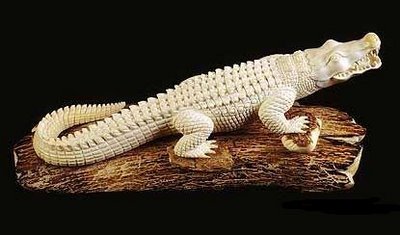Ivory carving is the carving of ivory, that is to say animal tooth or tusk, by using sharp cutting tools, either mechanically or manually.

Humans have ornamentally carved ivory since prehistoric times, and much of the prehistoric work reveals information about the use of tools during the carving's time period. The ivory figure of Khufu, for the builder of the Great Pyramid, is considered a masterpiece. Ivory carvings have been discovered in the tombs of ancient Chinese rulers. Since the late Roman era ivory has been a popular medium for Christian art. Many boxes, that held religious relics, or costly jewelry were made of ivory.


Ivory is by no means just obtained from elephants; any animal tooth or tusk used as a material for carving may be termed "ivory", though the species is usually added, and a great number of different species with tusks or large teeth have been used. Teeth have three elements: the outer dental enamel, then the main body of dentine, and the inner root of osteo-dentine. For the purposes of carving the last two are in most animals both usable, but the harder enamel may be too hard to carve, and require removal by grinding first. This is the case with hippopotamus for example, whose tooth enamel (on the largest teeth) is about as hard as jade. Elephant ivory, as well as coming in the largest pieces, is relatively soft and even, and an ideal material for carving. The species of animal from which ivory comes can usually be determined by examination under ultra-violet light, where different types show different colours.


Eurasian elephant ivory was usually obtained from the tusks of elephants in India, and in Roman times, from North Africa; from the 18th century sub-Saharan Africa became the main source. Ivory harvesting led to the extinction, or near-extinction of elephants in much of their former range. In early medieval Northern Europe, walrus ivory was traded south from as far away as Norse Greenland to Scandinavia, southern England and northern France and Germany. In Siberia and Artic North America, mammoth tusks could be recovered from permafrost and used; this became a large business in the 19th century, with convicts used for much of the labour. The 25,000 year-old Venus of Brassempouy, arguably the earliest real likeness of a human face, was carved from mammoth ivory no doubt freshly killed. Sperm whale teeth are another source, and bone carving has been used in many cultures without access to ivory, and as a far cheaper alternative.












Humans have ornamentally carved ivory since prehistoric times, and much of the prehistoric work reveals information about the use of tools during the carving's time period. The ivory figure of Khufu, for the builder of the Great Pyramid, is considered a masterpiece. Ivory carvings have been discovered in the tombs of ancient Chinese rulers. Since the late Roman era ivory has been a popular medium for Christian art. Many boxes, that held religious relics, or costly jewelry were made of ivory.


Ivory is by no means just obtained from elephants; any animal tooth or tusk used as a material for carving may be termed "ivory", though the species is usually added, and a great number of different species with tusks or large teeth have been used. Teeth have three elements: the outer dental enamel, then the main body of dentine, and the inner root of osteo-dentine. For the purposes of carving the last two are in most animals both usable, but the harder enamel may be too hard to carve, and require removal by grinding first. This is the case with hippopotamus for example, whose tooth enamel (on the largest teeth) is about as hard as jade. Elephant ivory, as well as coming in the largest pieces, is relatively soft and even, and an ideal material for carving. The species of animal from which ivory comes can usually be determined by examination under ultra-violet light, where different types show different colours.


Eurasian elephant ivory was usually obtained from the tusks of elephants in India, and in Roman times, from North Africa; from the 18th century sub-Saharan Africa became the main source. Ivory harvesting led to the extinction, or near-extinction of elephants in much of their former range. In early medieval Northern Europe, walrus ivory was traded south from as far away as Norse Greenland to Scandinavia, southern England and northern France and Germany. In Siberia and Artic North America, mammoth tusks could be recovered from permafrost and used; this became a large business in the 19th century, with convicts used for much of the labour. The 25,000 year-old Venus of Brassempouy, arguably the earliest real likeness of a human face, was carved from mammoth ivory no doubt freshly killed. Sperm whale teeth are another source, and bone carving has been used in many cultures without access to ivory, and as a far cheaper alternative.











कोई टिप्पणी नहीं:
एक टिप्पणी भेजें